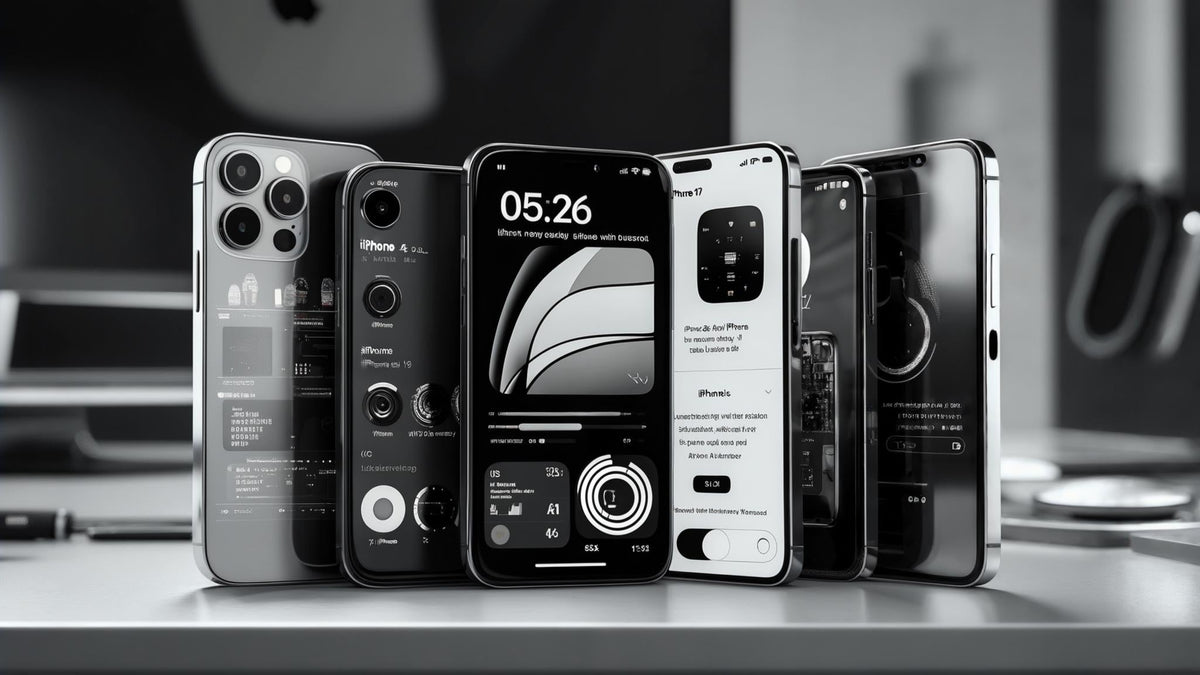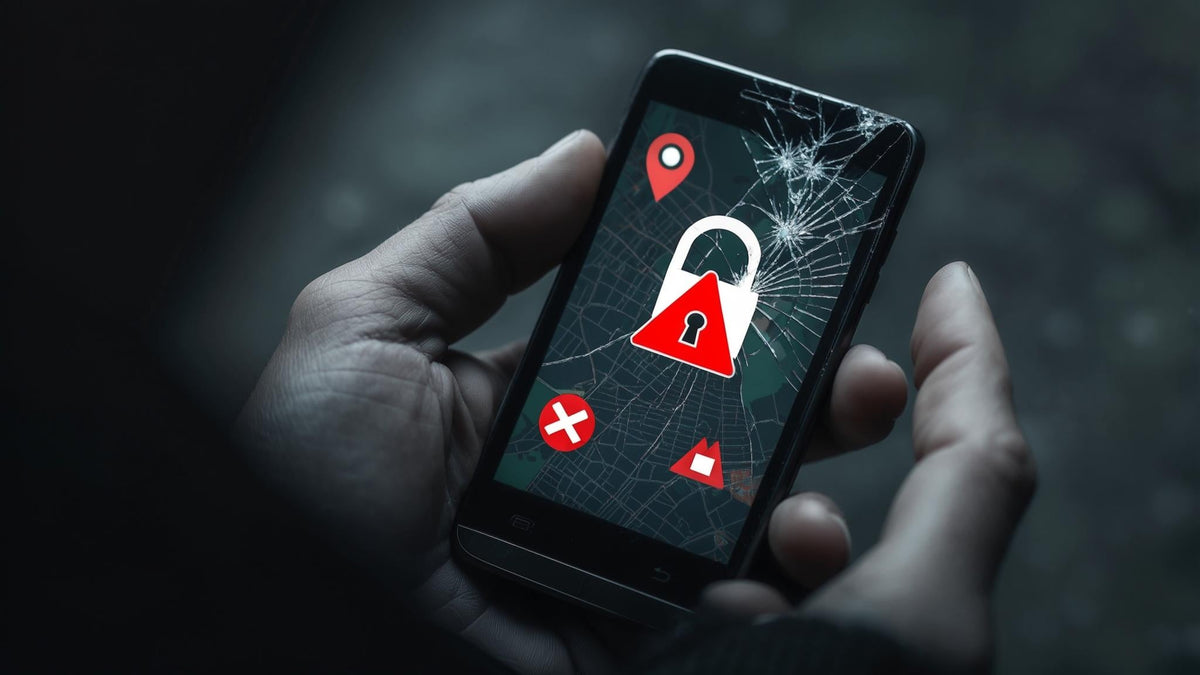Let's be honest - you've probably dropped your phone more times than you'd like to admit. Maybe it was that heart-stopping moment when it slipped from your pocket, or when you fumbled it getting out of your car. With the average smartphone costing around $363 and premium models reaching $1,000 or more, and 140 million Americans having damaged their smartphones at some point, understanding how do phone cases protect your phone isn't just smart - it's essential for your wallet and peace of mind.
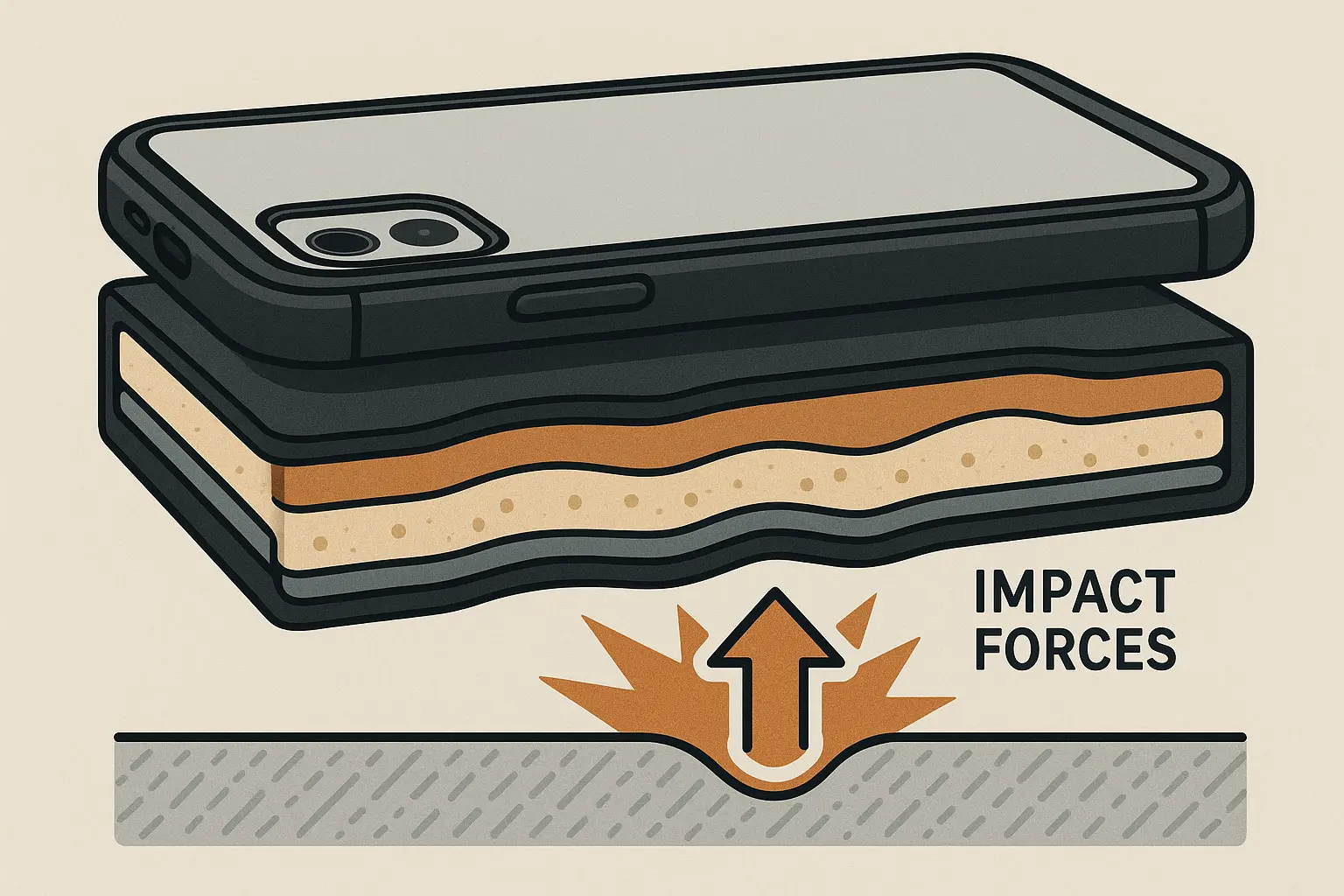
Table of Contents
Why Your Phone Is More Fragile Than You Think
What Those Drop Test Numbers Actually Mean
The Materials That Make the Difference
Military-Grade: More Than Marketing Hype
Protecting What Costs the Most
Beyond Drop Protection: Fighting Daily Hazards
Smart Features That Actually Help
When Your Phone Can't Fail
Making the Right Choice
The Bottom Line
TL;DR
Your smartphone is essentially a glass sandwich with delicate electronics that can be damaged by forces you can't see - cases use engineered materials like polycarbonate to absorb and distribute impact across multiple layers
Drop protection ratings (4-foot basic to 10+ foot military-grade) represent real testing standards, but corner drops concentrate the most dangerous forces
Raised edges around screens and cameras prevent direct contact - even 1-2mm makes the difference between working phones and expensive repairs
Quality cases seal vulnerable ports while maintaining functionality, protecting against dust and moisture that cause gradual damage
Advanced mounting systems and magnetic compatibility transform cases from simple protection into versatile tools for active lifestyles
Professional users need cases tested beyond consumer standards for chemical exposure, extreme conditions, and multiple severe impacts
Premium protection costs 5-15% of phone value but prevents repair costs often exceeding 50-80% of device worth
Why Your Phone Is More Fragile Than You Think
Your smartphone might feel solid in your hands, but it's essentially a glass sandwich filled with delicate electronics. When it hits the ground, the impact doesn't just affect what you can see on the surface - it sends vibrations throughout the device that can crack internal chips or knock them completely off the motherboard. Your screen might look perfectly fine, but your phone could be completely dead inside.
This is where understanding how do phone cases protect your phone gets interesting from a physics perspective. A good phone case doesn't just cushion the blow like a pillow - it's specifically engineered to absorb the shock energy and spread it across the entire case structure instead of letting it hammer your phone's delicate internals.
Modern smartphones contain hundreds of tiny components that can be damaged by forces you can't even see. The impact creates vibrations that travel through the device, potentially lifting chips right off the motherboard or cracking internal connections - making your phone completely useless even if the screen looks perfect.
What Those Drop Test Numbers Actually Mean
You've seen the marketing claims plastered on case packaging: "6-foot drop protection!" But what does that really mean for your daily life?
Protection Level |
Drop Height |
Real-World Use |
Testing Standard |
|---|---|---|---|
Basic Consumer |
4-5 feet |
Everyday fumbles, pocket drops |
Standard impact testing |
Premium Consumer |
6-8 feet |
Active lifestyles, outdoor use |
Multi-angle drop testing |
Military-Grade |
10+ feet |
Professional, extreme conditions |
MIL-STD-810G protocols |
Ultra-Protective |
15-30 feet |
Construction, military use |
Custom extreme testing |
The catch? These numbers assume perfect conditions. Real-world drops involve uneven surfaces, multiple bounces, and awkward angles that can push any case beyond its limits.
Why Corner Drops Are Your Phone's Worst Enemy
Here's something most people don't realize: corner drops are absolutely devastating to phones. All that impact force gets concentrated on one tiny point, which is why you'll see phones survive face-down drops but completely shatter from corner impacts.
Think about dropping a raw egg on a pillow versus dropping it on a concrete corner. The pillow distributes the impact across a large surface area, while the corner concentrates all the force on one tiny point. How do phone cases protect your phone from this? Quality cases have reinforced corners with specialized shock-absorbing materials that spread that concentrated force across the entire protective structure.
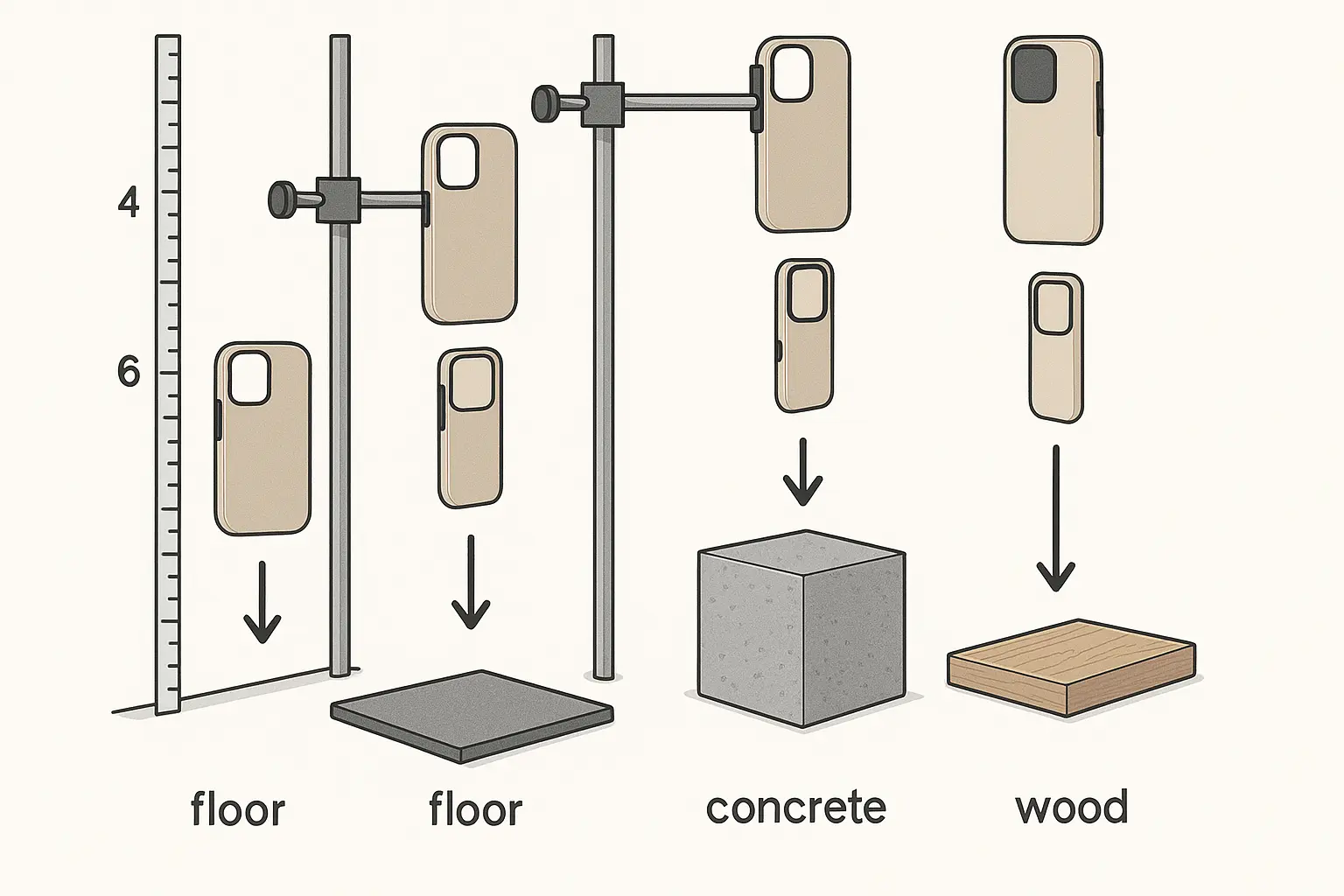
Height-Based Protection: The Reality Behind the Numbers
When manufacturers claim "6-foot drop protection," they're telling you the maximum height your phone can fall from while staying undamaged under controlled conditions. But real-world drops are messier - they involve concrete sidewalks, gravel parking lots, and multiple bounces that can exceed these ratings.
The key difference between protection levels isn't just height - it's the comprehensiveness of testing. Military-grade cases undergo 26+ drops from multiple angles, while basic cases might only be tested from a few positions. This thorough testing reveals how cases actually perform when physics gets unpredictable.
The Materials That Make the Difference
Not all plastics are created equal, and this is where the science of protection gets fascinating. The best cases use polycarbonate - a special engineered plastic that's flexible enough to bend under stress instead of cracking like cheap alternatives.
This flexibility is absolutely key to understanding how do phone cases protect your phone effectively. Polycarbonate's long polymer chains can stretch and bend when hit, absorbing energy that would otherwise transfer directly to your phone's internal components. This is why the best protective cases feel slightly flexible rather than rigid - they're engineered to give a little to protect a lot.
Polycarbonate Engineering: Why This Plastic Matters
Polycarbonate isn't just any plastic - it's a thermoplastic specifically engineered for impact resistance. The material's molecular structure allows it to bend slightly upon impact, dissipating force rather than transferring it directly to your device. This is why cheap cases that feel completely rigid often provide inferior protection despite seeming "stronger."
What to look for in quality materials:
Flexibility under stress (should bend slightly, not crack)
Impact absorption rating (look for specific joule ratings)
Temperature resistance (-40°F to 140°F minimum)
UV stability (won't degrade in sunlight)
Chemical resistance (oils, cleaning products)
Multi-Layer Defense Systems: Building Comprehensive Protection
Advanced cases don't rely on single materials working alone. They use multiple layers working together - outer shells for structural integrity, inner shock-absorbing layers for cushioning, and sometimes air gap technology that creates space between the case and phone for additional energy absorption.
Think of it like modern body armor - it's not just one thick plate, but multiple specialized layers each designed to handle different types of threats. The outer layer spreads impact, the middle layer absorbs energy, and the inner layer provides final cushioning.
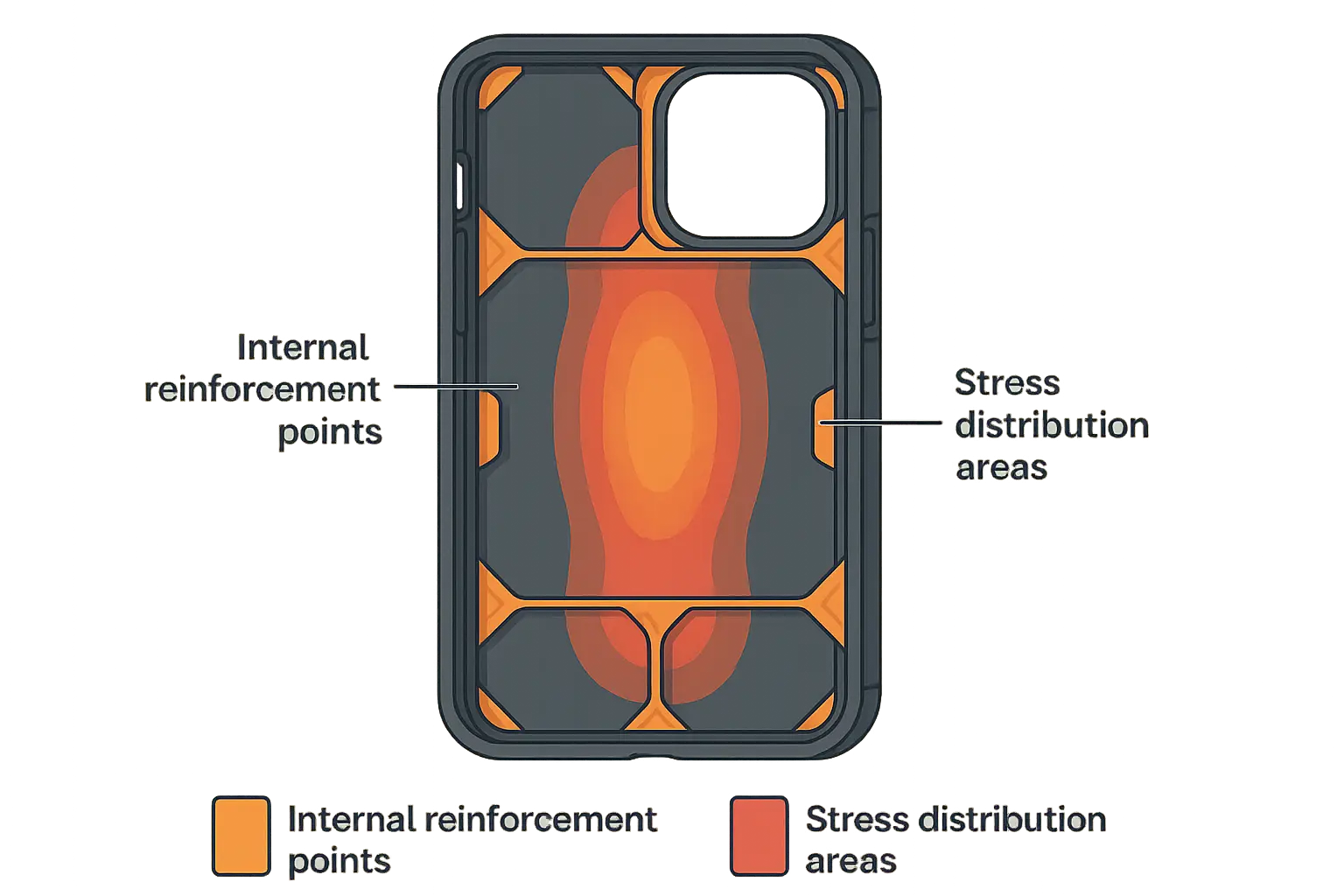
Military-Grade: More Than Marketing Hype
When a case claims "military-grade," it should mean something specific: MIL-STD-810G certification. This involves rigorous testing protocols including 26+ drops from minimum heights, shock resistance testing, and environmental endurance trials. Only cases that undergo and pass these strict protocols earn genuine military-grade designation.
True military-grade certification isn't marketing fluff - it represents extensive testing that goes far beyond consumer use. The engineering involves strategic material placement at critical stress points, reinforcement where physics demands it most, and construction that can withstand multiple severe impacts without compromising protection.
According to OtterBox's testing protocols, their military-grade cases undergo DROP+ testing that exceeds standard MIL-STD-810G requirements, conducting up to 182 drops to ensure no damage occurs to any part of the phone. For professionals who demand the most protective phone cases in extreme conditions, understanding these standards becomes essential.
Strategic Reinforcement: Engineering Protection Where It Counts
The engineering focuses on strategic reinforcement at stress points like corners and button areas, rather than just making the entire case thicker. Critical areas receive additional reinforcement through thicker material sections or specialized shock-absorbing inserts.
This targeted approach ensures maximum protection where physics demands it most without adding unnecessary bulk to the entire case. It's smart engineering that puts material exactly where impact forces concentrate during real-world drops.
Stress Distribution Technology: Spreading the Impact Load
The goal isn't just to absorb impact energy - it's to spread that energy across the largest possible surface area. This prevents the concentrated force that causes internal component damage even when the screen survives the drop.
Advanced cases use internal ribbing, strategic thickness variations, and engineered flex points that work together to distribute impact forces away from your phone's vulnerable components.
Protecting What Costs the Most
Your phone's screen and camera system represent the most vulnerable and expensive components to repair or replace. Screen replacements alone can cost $200-400 for flagship devices, while camera repairs often require complete module replacement. A quality case costing $50-100 prevents repair bills that can easily hit 50-80% of your phone's original value.
The secret lies in those raised edges around your screen and camera - even 1-2mm of lip height can mean the difference between a working phone and an expensive repair shop visit. When your phone lands face-down on concrete, that tiny barrier keeps the glass suspended safely above the surface.
When choosing protection, understanding which iphone has the best camera helps determine the level of camera protection your specific device requires, since more advanced camera systems often need more sophisticated protection strategies.
Raised Edge Protection: The Millimeters That Save Hundreds
Think of raised edges as bumpers on a car. When you park too close to a wall, the bumper hits first and protects the expensive bodywork. Similarly, when your phone lands face-down, the case's raised lip hits the ground first, keeping your screen suspended safely above the surface - even on rough concrete or gravel.
Screen protection measurement guide:
Minimum effective lip height: 1mm
Recommended for daily use: 1.5-2mm
Heavy-duty protection: 2.5mm+
Maximum practical height: 3mm (beyond this affects usability)
That tiny raised edge around your screen isn't an afterthought - it's precisely calculated protection based on real-world testing and physics principles.
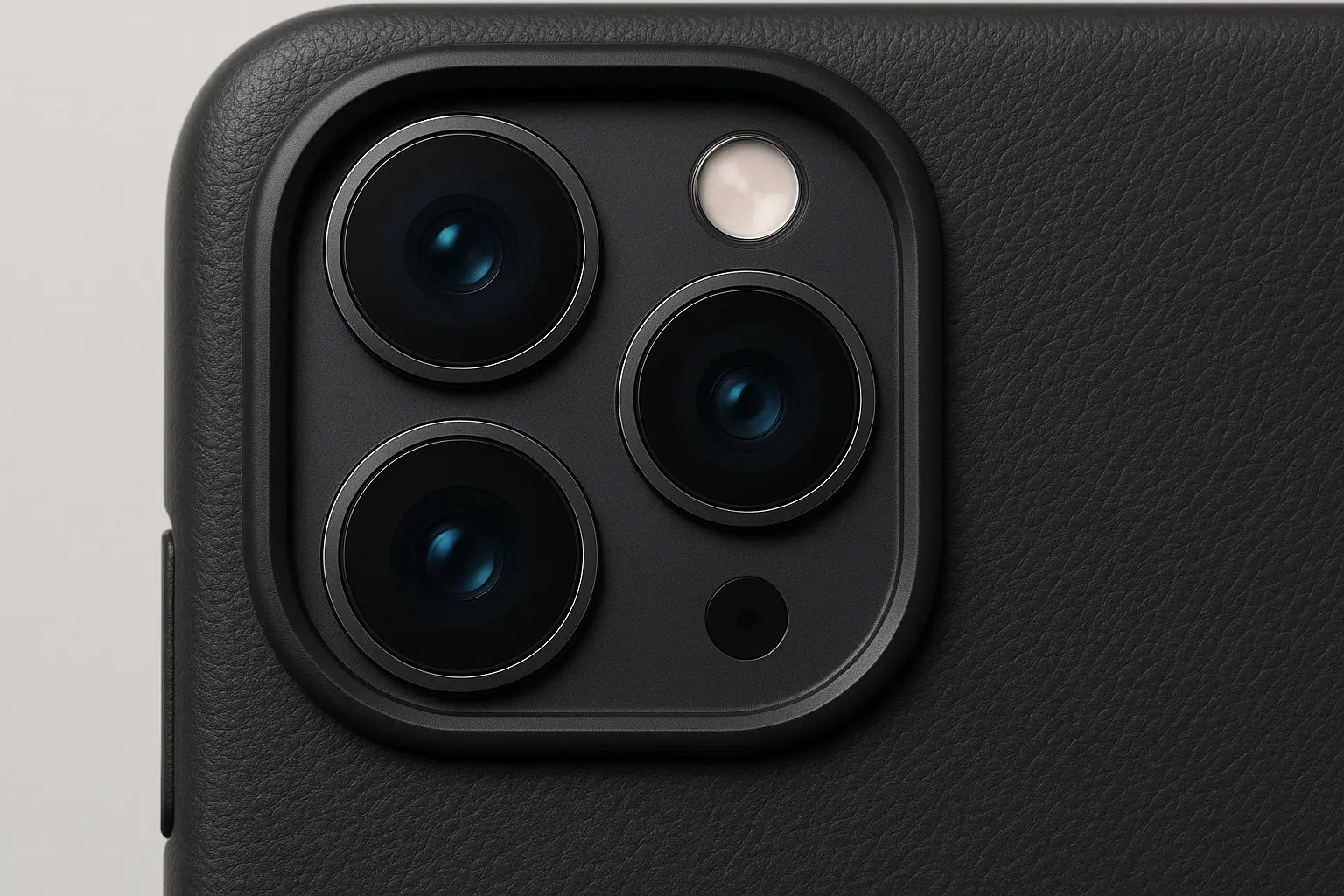
Camera Bump Protection: Defending Your Photography Investment
Camera protection is trickier because modern camera systems stick out significantly from the phone's back surface. These protrusions are scratch magnets and impact targets that need specialized protection strategies.
Quality cases surround and exceed the height of camera lenses, preventing damage from sliding across surfaces and protecting against direct impacts. This is particularly crucial with Apple's introduction of the ultra-thin iPhone Air at just 5.6mm thick in 2025, where even minimal camera protection adds significant bulk to the revolutionary design.
Screen Protector Integration: Making Protection Work Together
The most effective protection strategy combines quality cases with tempered glass screen protectors. Case design must accommodate the additional thickness of screen protection without creating gaps or interference issues.
For comprehensive defense, pairing quality cases with best iphone glass screen protectors creates the ultimate protection system for your device's display.
Properly engineered cases feature precise cutouts and lip heights that work harmoniously with various screen protector thicknesses, creating comprehensive defense that doesn't compromise functionality.
Beyond Drop Protection: Fighting Daily Hazards
Real-world phone protection extends far beyond drop defense to include environmental hazards that can gradually damage your device over time. Dust, debris, and moisture infiltration through ports and openings pose constant threats that quality cases address through integrated sealing systems.
Environmental damage often occurs gradually and invisibly. Dust particles can interfere with charging connections, moisture can cause internal corrosion, and repeated exposure to oils and debris can degrade components long before you notice any problems.
Port and Opening Defense: Sealing Vulnerable Entry Points
Your phone's charging port, speakers, and microphone openings provide entry points for dust, dirt, and moisture that can cause gradual damage or sudden failure. Advanced cases feature integrated port covers or precision-fitting plugs that seal these openings when not in use.
Quality cases protect physical buttons through precision-molded covers that maintain tactile feedback. You shouldn't have to sacrifice button responsiveness for protection - good engineering gives you both full protection and natural feel.
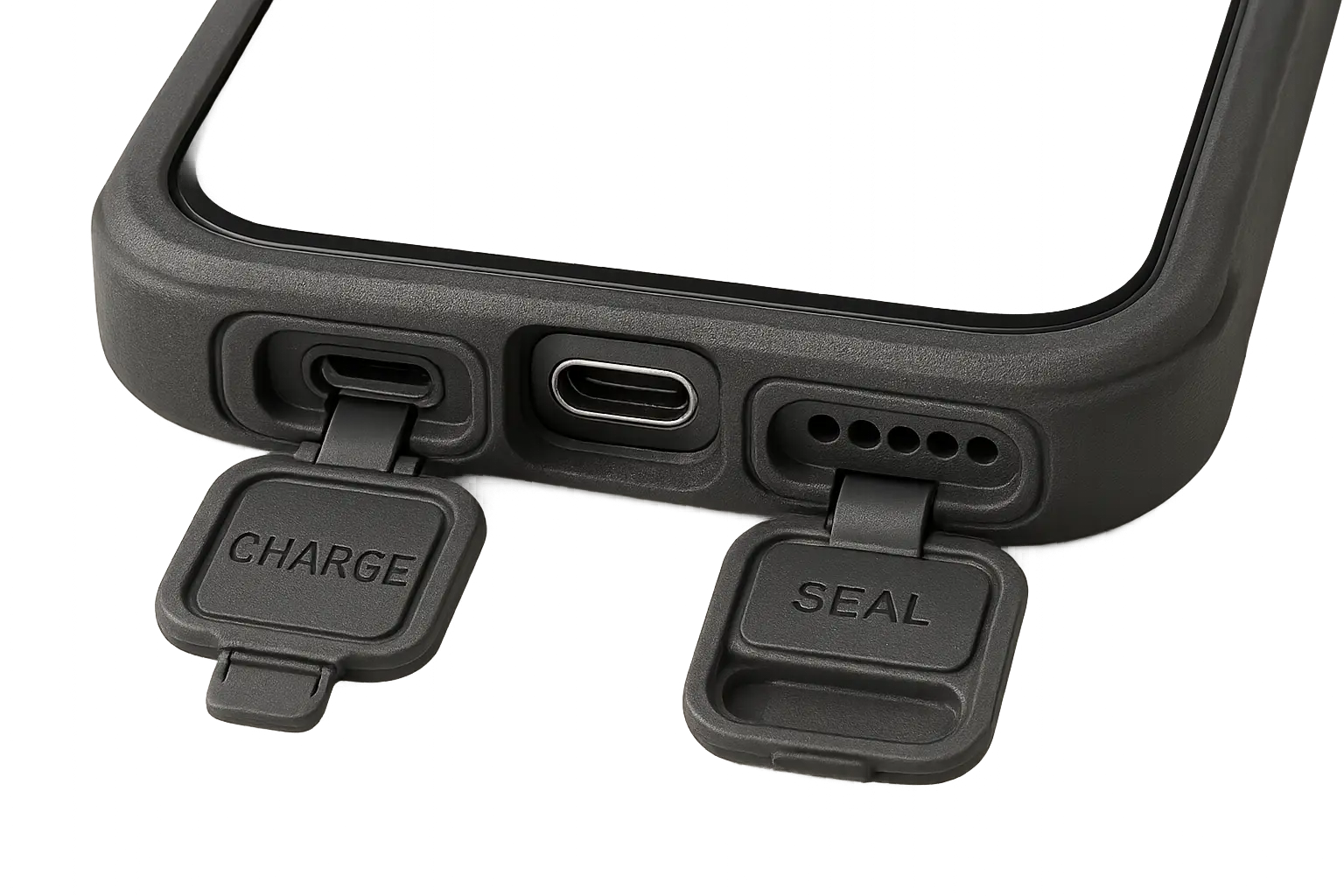
Environmental protection checklist:
Port covers that seal completely when closed
Button covers that maintain tactile feedback
Speaker/microphone grilles that allow clear sound passage
Wireless charging compatibility maintained
Easy access for daily use without compromising protection
Magnetic Interference Prevention: Protecting Invisible Systems
Modern phones rely heavily on magnetic systems for charging and accessories, creating new protection challenges that most people never consider. Quality cases incorporate magnetic shielding that prevents interference with internal components while maintaining compatibility with MagSafe and wireless charging systems.
This requires precise engineering to allow beneficial magnetic connections while blocking harmful magnetic fields that could disrupt your phone's internal systems.
Smart Features That Actually Help
Modern phone cases have evolved beyond simple protection to become versatile platforms that enhance your device's functionality. Advanced mounting systems transform cases into secure attachment points for various activities, while magnetic mounting technology uses industrial-grade magnets providing holding strength measured in pounds of pull force.
The evolution from basic protection to smart functionality represents a fundamental shift in case design philosophy. Today's best cases don't just protect your phone - they make it more useful and versatile for your specific lifestyle needs.
Modern cases have evolved beyond simple protection, with innovations like what is a magnetic phone case transforming how we interact with our devices in daily life.
Secure Mounting Systems: Your Phone as a Versatile Tool
Professional-grade cases feature proprietary mounting systems that allow secure attachment to various surfaces and accessories. Twist-lock mechanisms provide tool-free mounting and removal while ensuring phones remain securely attached during high-vibration activities like motorcycle riding or mountain biking.
Mounting System |
Holding Strength |
Best Use Cases |
Installation Method |
|---|---|---|---|
Magnetic Mount |
15-25 lbs pull force |
Dashboard, refrigerator, metal surfaces |
Instant attachment |
Twist-Lock System |
40+ lbs retention |
Motorcycle, bicycle, industrial use |
Quarter-turn locking |
Suction Cup Mount |
10-20 lbs hold |
Windshield, smooth surfaces |
Lever activation |
Clamp Mount |
30+ lbs grip |
Desk edges, equipment rails |
Screw tightening |
These systems transform protective cases into versatile mounting platforms that adapt to your lifestyle needs.
Magnetic Mounting Technology: Industrial Strength for Daily Use
Advanced magnetic mounting uses rare-earth magnets powerful enough to hold phones against significant forces while remaining easily removable. We're talking about holding strength measured in pounds of pull force - serious engineering for serious use.
A motorcycle rider using a twist-lock mount can remove their phone for navigation updates at traffic stops, then secure it again with a simple quarter-turn - no tools, no fumbling, just reliable attachment that survives highway speeds and road vibration.
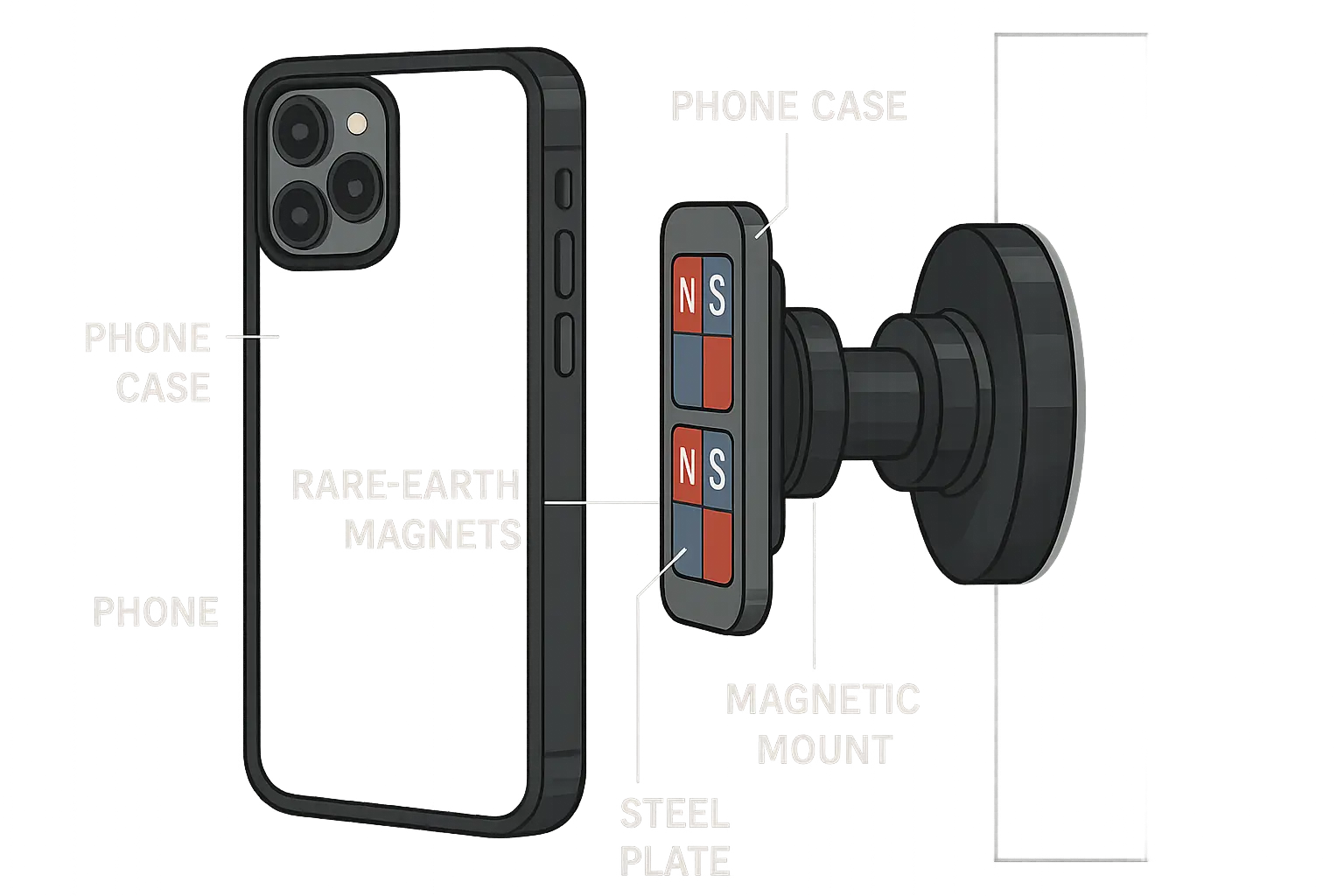
Grip Enhancement: Preventing Drops Before They Happen
The best drop protection is preventing drops altogether. Cases with textured surfaces, grip channels, or rubberized materials give you secure handling even with wet or gloved hands. This proactive approach makes impact protection your backup plan rather than your primary defense.
Quality cases also maintain natural balance and weight distribution, avoiding the top-heavy feel that can actually increase drop likelihood while providing superior protection. Advanced cases incorporate strategic grip channels that provide secure handling without compromising the sleek profile.
When Your Phone Can't Fail
Emergency personnel, military users, and professionals in high-risk environments face unique protection challenges where phone failure isn't just inconvenient - it's potentially dangerous. These applications demand cases that maintain functionality after multiple severe impacts, exposure to chemicals, extreme temperatures, and high-vibration conditions.
Recent industry analysis shows that phone repair costs continue to escalate, with flagship screen replacements often costing over $300 depending on the model. This makes a $50 case and $30 screen protector combination - representing only 5% of a $1,600 phone's value - an increasingly smart investment.
For those in demanding professions, specialized cases like best phone cases paramedics provide the reliability needed when communication failures aren't an option and lives depend on reliable device operation.
Professional Protection Requirements: Beyond Consumer Standards
First responders and military personnel can't afford phone failures during critical situations. Their cases undergo testing that simulates chemical exposure, extreme temperatures, and multiple severe impacts because reliable communication can literally save lives.
What professional protection requires:
Chemical resistance (cleaning agents, fuel, bodily fluids)
Temperature extremes (-40°F to 160°F operational)
Multiple severe impact survival without functionality loss
Vibration resistance for vehicle mounting applications
Water immersion protection (IP68 rating minimum)
Electromagnetic interference shielding capabilities
Vehicle Use Creates Unique Challenges
If you mount your phone in a car or motorcycle, constant vibration gradually damages internal components over time. Specialized cases include vibration dampening materials and secure mounting systems that protect against both impact damage and the cumulative effects of engine vibration and road shock.
Automotive and motorcycle integration subjects phones to constant vibration that can damage delicate internal components. Quality cases incorporate vibration dampening technology that protects against both immediate impact damage and long-term degradation from constant movement.
Outdoor Activities Demand Weather Protection
Hiking, camping, or working outdoors exposes your phone to moisture, temperature swings, and environmental contaminants that can kill devices slowly over time. Enhanced sealing around ports and joints protects against rain, snow, and humidity damage.
Outdoor recreation protection requires enhanced weather resistance through improved sealing systems that maintain functionality while blocking environmental hazards that gradually compromise device integrity.
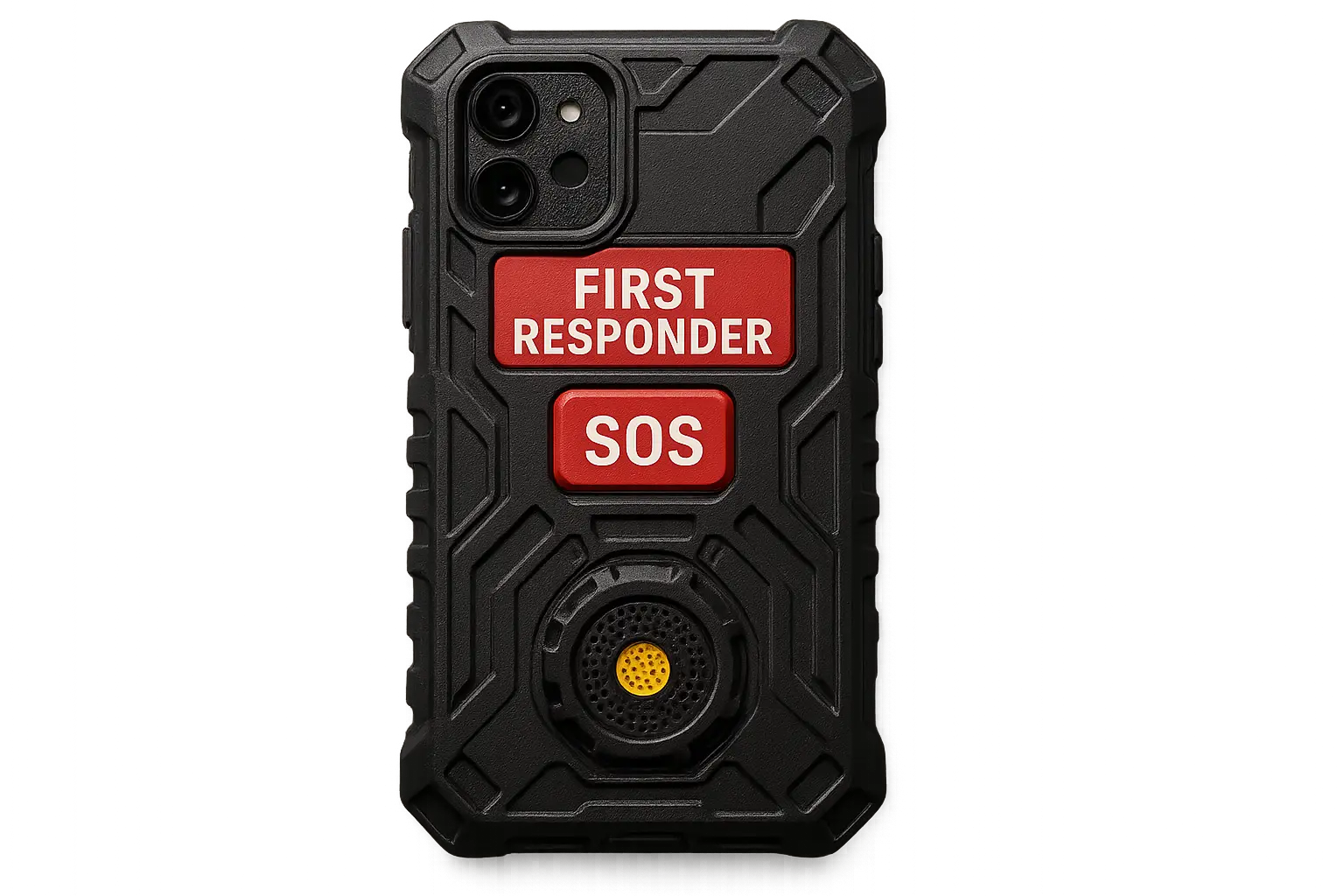
Making the Right Choice
Evaluating phone case protection requires understanding testing standards, certifications, and what protection ratings actually mean in real-world use. Independent testing verification separates legitimate protection claims from marketing hype, while manufacturer warranties demonstrate confidence in protection capabilities.
Research shows that within 10 weeks of purchase, half of all new phone users will drop their handset, making protection a statistical inevitability rather than just a precaution. Understanding how do phone cases protect your phone becomes essential knowledge for every smartphone owner.
Look Past the Marketing: Real Testing Standards Matter
Many manufacturers make protection claims without independent verification, making it crucial to look for cases tested by recognized standards organizations. Real protection requires real testing, not just marketing claims.
Certification verification checklist:
MIL-STD-810G certification (if claimed)
Independent lab testing results available
Specific drop height and angle testing protocols
Environmental condition testing documentation
Video evidence of testing procedures
Third-party validation reports
The most confident case manufacturers offer device protection warranties or replacement programs - they're putting their money where their protection claims are, demonstrating genuine faith in their engineering.
The Math That Matters: Protection ROI
Understanding the return on investment for quality protection reveals why premium cases represent excellent value. A quality case costs 5-15% of your phone's value but prevents repair costs that often hit 50-80% of device worth.
Consider this real-world example: A $1,200 flagship smartphone with a $60-120 premium protective case versus a $300-400 screen replacement cost. Even preventing just one repair pays for the case 2-3 times over while maintaining your device's resale value and avoiding the inconvenience of repairs.
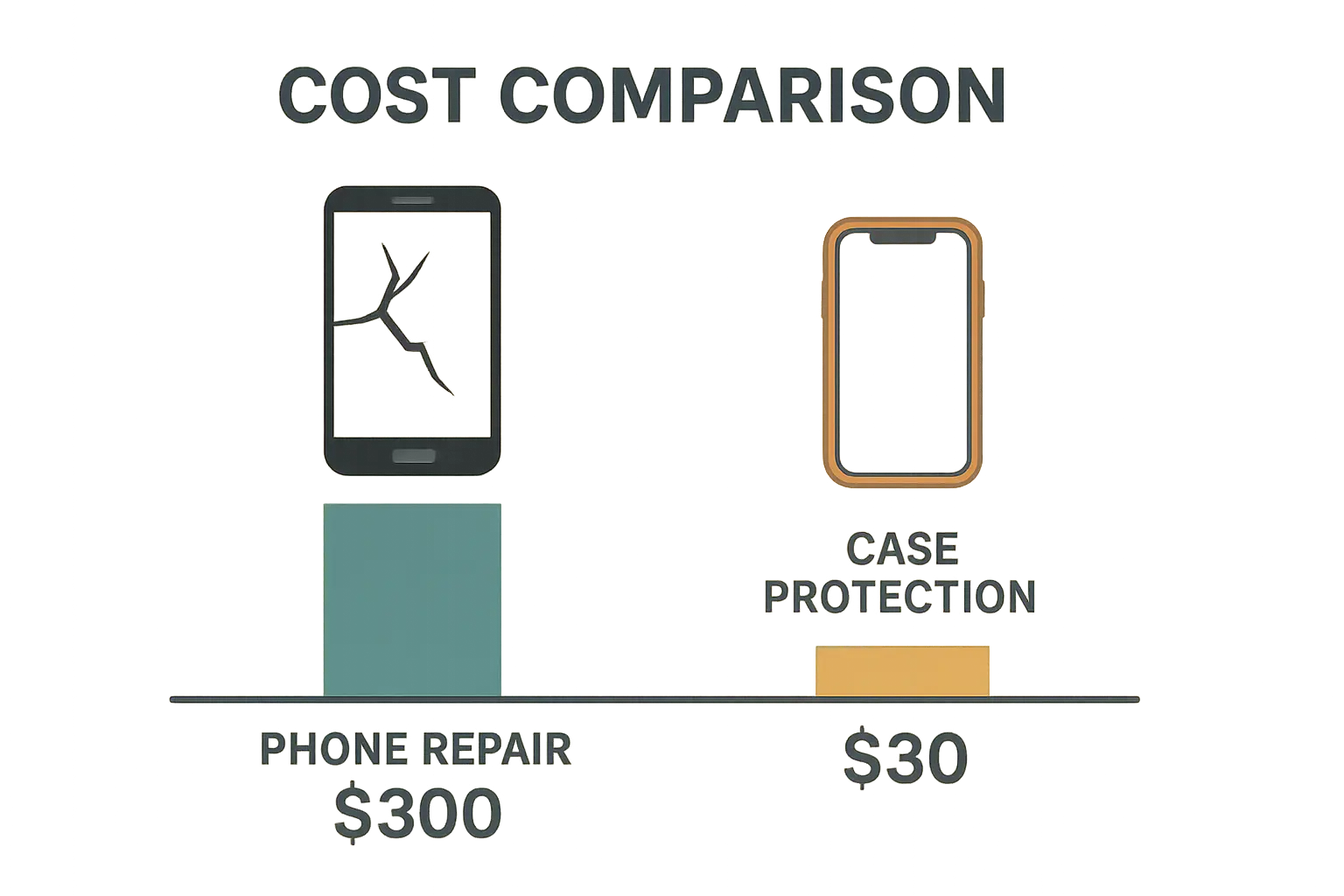
Premium smartphone models often reach price tags of $1,000 and up, while quality protective cases typically cost between 5-15% of the device's value, making them one of the most cost-effective investments for device longevity and peace of mind.
What Your Lifestyle Actually Needs
Office worker: Basic 4-foot protection with good grip enhancement
Active lifestyle: 6-8 foot protection with environmental sealing capabilities
Outdoor enthusiast: Weather resistance and mounting compatibility features
Professional user: Military-grade protection with specialized features for your field
Different activities create unique protection challenges that require tailored solutions. Understanding your specific needs helps determine the right balance between protection level, features, and cost.
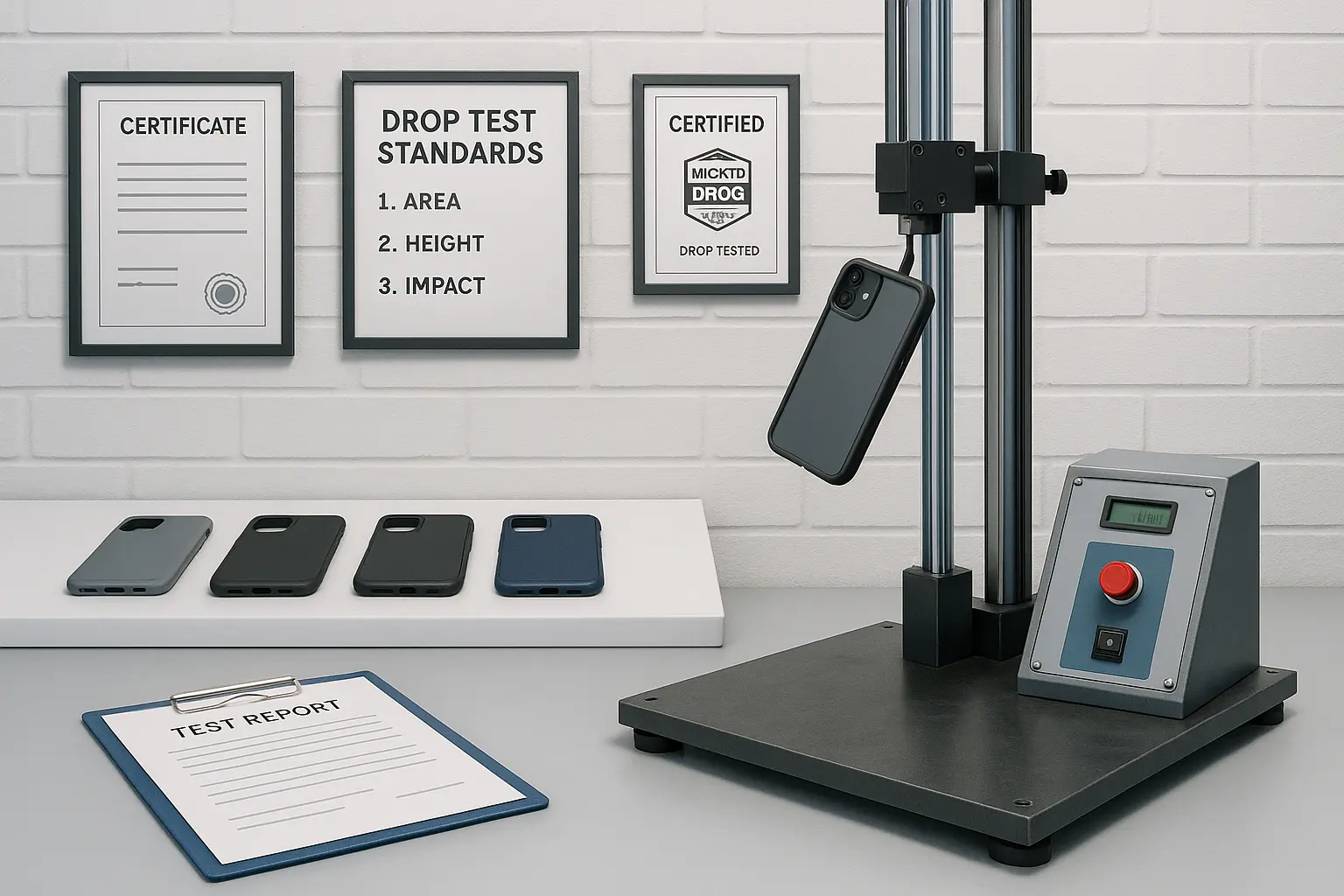
The Bottom Line
Phone protection has evolved way beyond simple drop defense into comprehensive engineering that addresses every threat your device faces. From the physics of impact absorption to environmental sealing, from professional-grade mounting systems to ergonomic design that prevents drops before they happen - quality protection requires attention to details that aren't immediately obvious.
Understanding how do phone cases protect your phone reveals the sophisticated engineering behind effective protection. Modern cases address impact physics, environmental hazards, mounting versatility, and daily usability challenges through integrated design solutions that transform simple protection into comprehensive device enhancement.
The investment in quality protection makes financial sense when you consider repair costs, but more importantly, it makes practical sense given how much you rely on your phone. Whether you're navigating emergencies, capturing important moments, or simply staying connected with people who matter, your phone needs protection that matches its importance in your life.
For users who demand professional-grade protection without compromising functionality, Rokform addresses the complete spectrum of protection challenges. Their military-grade polycarbonate construction provides 6-foot drop protection with 4x better performance than competing cases, while their patented RokLock™ twist-lock system and MAGMAX™ magnets solve the common problem of choosing between protection and versatility.
Whether you're a first responder needing reliable communication during emergencies, an outdoor enthusiast requiring weather-resistant protection, or simply someone who wants their phone to survive daily life, Rokform's comprehensive approach ensures your device stays protected and functional when it matters most.
The choice is simple: Spend a small percentage of your phone's value on proven protection, or risk spending much more on repairs while dealing with the inconvenience of a damaged device. Quality cases are too affordable, and your phone is too important, to leave protection to chance.
Ready to give your phone the protection it deserves? Explore Rokform's complete protection solutions and discover why professionals trust their devices to military-grade engineering that delivers both protection and versatility.
Don't wait for that first expensive drop to teach you the value of real protection. Your future self will thank you for making the smart choice today.








